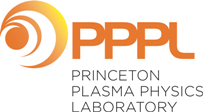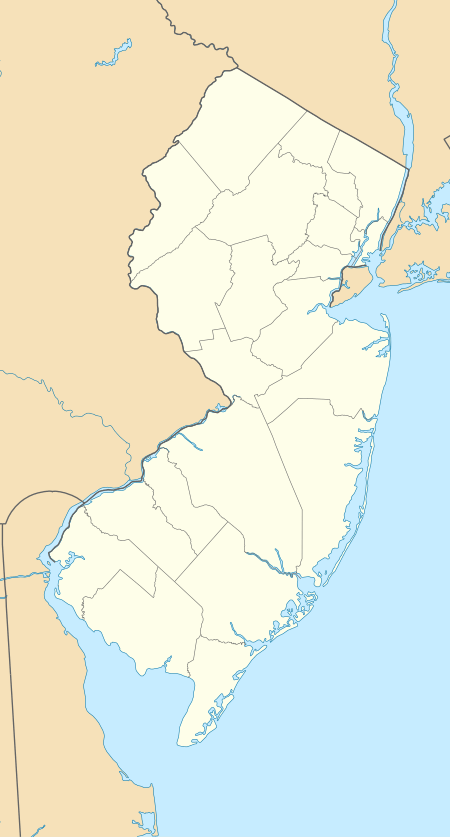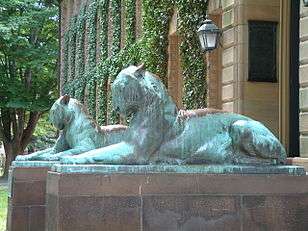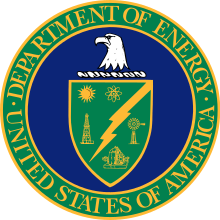Princeton Plasma Physics Laboratory
Princeton Plasma Physics Laboratory (PPPL) is a United States Department of Energy national laboratory for plasma physics and nuclear fusion science. Its primary mission is research into and development of fusion as an energy source.
 | |
| Established | 1961 |
|---|---|
| Budget | $93 million (2017)[1] |
Field of research | Plasma physics |
| Vice president | David J. McComas, Vice-President for PPPL |
| Director | Steven Cowley[2] |
| Address | 100 Stellarator Road, Princeton New Jersey |
| Location | Plainsboro Township, New Jersey, United States 40.348825°N 74.602183°W |
Zip code | 08536 |
| Campus | Forrestal Campus |
Operating agency | Princeton University |
| Website | www |
| Map | |
 Location in New Jersey | |
PPPL grew out of the top secret Cold War project to control thermonuclear reactions, called Project Matterhorn. In 1961, after declassification, Project Matterhorn was renamed the Princeton Plasma Physics Laboratory.[3]
PPPL is located on Princeton University's Forrestal Campus in Plainsboro Township, New Jersey. This is some distance from the main Princeton campus, but the lab has a Princeton address.
History
In 1950, John Wheeler was setting up a secret H-bomb research lab at Princeton University. Lyman Spitzer, Jr., an avid mountaineer, was aware of this program and suggested the name "Project Matterhorn".[4]
Spitzer, a professor of Astronomy, had for many years been involved in the study of very hot rarefied gases in interstellar space. While leaving for a ski trip to Aspen in February 1951, his father called and told him to read the front page of the New York Times. The paper had a story about claims released the day before in Argentina that a relatively unknown German scientist named Ronald Richter had achieved nuclear fusion in his Huemul Project.[5] Spitzer ultimately dismissed these claims, and they were later proven erroneous, but the story got him thinking about fusion. While riding the chairlift at Aspen, he struck upon a new concept to confine a plasma for long periods so it could be heated to fusion temperatures. He called this concept the stellarator.
Later that year he took this design to the Atomic Energy Commission in Washington. As a result of this meeting and a review of the invention by scientists throughout the nation, the stellarator proposal was funded in 1951. As the device would produce high-energy neutrons, which could be used for breeding weapon fuel, the program was classified and carried out as part of Project Matterhorn. Matterhorn ultimately ended its involvement in the bomb field in 1954, becoming entirely devoted to the fusion power field.
In 1958, this magnetic fusion research was declassified following the 1955 United Nations International Conference on the Peaceful Uses of Atomic Energy. This generated an influx of graduate students eager to learn the "new" physics, which in turn influenced the lab to concentrate more on basic research.[6]
The early figure-8 stellarators included : Model-A, Model-B, Model-B2, Model-B3.[7] Model-B64 was a square with round corners, and Model-B65 was a racetrack configuration.[7] The last and most powerful stellarator at this time was the 'racetrack' Model C (operating from 1961 to 1969).[8] The Model C was reconfigured as a tokamak in 1969,[7] becoming the Symmetric Tokamak (ST).[9]
In the 1970s research at the PPPL refocused on the Russian tokamak design when it became evident that it was a more satisfactory containment design than the stellarator. In May 1972 the Adiabatic Toroidal Compressor (ATC) began operation. The Princeton Large Torus, a tokamak, operated from 1975.
By 1982, the PPPL under the direction of Harold Furth had the Tokamak Fusion Test Reactor (TFTR) online, which operated until 1997.[10] Beginning in 1993, TFTR was the first in the world to use 50/50 mixtures of deuterium-tritium. In 1994 it yielded an unprecedented 10.7 megawatts of fusion power.[10]
In 1999, the National Spherical Torus Experiment (NSTX), based on the spherical tokamak concept, came online at the PPPL. Laboratory scientists are collaborating with researchers on fusion science and technology at other facilities, both domestic and foreign. Staff are applying knowledge gained in fusion research to a number of theoretical and experimental areas including materials science, solar physics, chemistry, and manufacturing.
Odd-parity heating was demonstrated in the 4 cm radius PFRC-1 experiment in 2006. PFRC-2 has a plasma radius of 8 cm. Studies of electron heating in PFRC-2 reached 500 eV with pulse lengths of 300 ms.[11]
In 2015, the U.S. Department of Energy's Princeton Plasma Physics Laboratory (PPPL) completed the National Spherical Torus Experiment Upgrade (NSTX-U) that makes it the most powerful experimental fusion facility, or tokamak, of its type in the world. Experiments will test the ability of the upgraded spherical facility to maintain a high-performance plasma under conditions of extreme heat and power. Results could strongly influence the design of future fusion reactors.[12]
In 2017, the group received a Phase II NIAC grant along with two NASA STTRs funding the RF subsystem and superconducting coil subsystem.[11]
Directors
In 1961 Gottlieb became the first director of the renamed Princeton Plasma Physics Laboratory.[13][14]
- 1951-1961: Lyman Spitzer, director of Project Matterhorn
- 1961-1980: Melvin B. Gottlieb
- 1981-1990: Harold Fürth
- 1991-1996: Ronald C. Davidson[10]
- 1997 (January–July): John A. Schmidt, interim director[10]
- 1997-2008: Robert J. Goldston[15]
- 2008–2016: Stewart C. Prager[16]
- 2016–2017: Terrence K. Brog (interim)[17]
- 2017–2018: Richard J. Hawryluk (interim)[18]
- 2018-present: Sir Steven Cowley, 1 July 2018[19]
Timeline of major research projects and experiments

Other experiments
- International Thermonuclear Experimental Reactor (ITER)
Plasma science and technology
- Beam Dynamics and Nonneutral Plasma
- Laboratory for Plasma Nanosynthesis (LPN)[20]
Theoretical plasma physics
- DOE Scientific Simulation Initiative
- U.S. MHD Working Group
- Field Reversed Configuration (FRC) Theory Consortium
- Tokamak Physics Design and Analysis Codes
- TRANSP Code
- National Transport Code Collaboration (NTCC) Modules Library
See also
References
- "Scholarship and Research". A Princeton Profile. Princeton University. Retrieved 10 May 2019.
- "10 Questions for Steven Cowley, New Director of the Princeton Plasma Physics Laboratory | Princeton Plasma Physics Lab". www.pppl.gov.
- Tanner, Earl C. (1977) Project Matterhorn: an informal history Princeton University Plasma Physics Laboratory, Princeton, New Jersey, p. 77, OCLC 80717532
- "Timeline". Princeton Plasma Physics Laboratory.
- Burke, James (1999) The Knowledge Web: From Electronic Agents to Stonehenge and Back -- And Other Journeys Through Knowledge Simon & Schuster, New York, pp. 241-42, ISBN 0-684-85934-3
- Bromberg, Joan Lisa (1982) Fusion: Science, Politics, and the Invention of a New Energy Source MIT Press, Cambridge, Massachusetts, p. 97, ISBN 0-262-02180-3
- "Highlights in Early Stellarator Research at Princeton. Stix. 1997" (PDF).
- "Experiments on the Model C stellarator. S. Yoshikawa and T.H. Stix". doi:10.1088/0029-5515/25/9/047. Cite journal requires
|journal=(help) - "Timeline | Princeton Plasma Physics Lab". www.pppl.gov.
- Staff (1996) "Fusion Lab Planning Big Reactor's Last Run" The Record, 22 December 1996, p. N-07
- Wang, Brian (June 22, 2019). "Game Changing Direct Drive Fusion Propulsion Progress – NextBigFuture.com". www.nextbigfuture.com. Retrieved 2019-06-22.
- "National Spherical Torus Experiment Upgrade (NSTX-U) | Princeton Plasma Physics Lab". www.pppl.gov.
- Bromberg, Joan Lisa (1982) Fusion: Science, Politics, and the Invention of a New Energy Source MIT Press, Cambridge, Massachusetts, p. 130, ISBN 0-262-02180-3
- "History". Princeton Plasma Physics Laboratory. Archived from the original on 2009-05-12.
- Stern, Robert (2007) "Princeton fusion center to lose influential leader" The Star-Ledger Newark, New Jersey, 15 December 2007, p. 20
- "Press Release, Prager to lead DOE's Princeton Plasma Physics Laboratory". Retrieved 2008-08-09.
- "PPPL Director Stewart Prager Steps Down | Princeton Plasma Physics Lab". www.pppl.gov.
- "PPPL has a new interim director and is moving ahead with construction of prototype magnets | Princeton Plasma Physics Lab". www.pppl.gov.
- "Steven Cowley named director of DOE's Princeton Plasma Physics Laboratory". 2018-05-16. Archived from the original on 2018-05-16.
- "Laboratory for Plasma Nanosynthesis" (LPN)", Princeton Plasma Physics Laboratory, accessed 16 May 2018
External links
- Project Matterhorn Publications and Reports, 1951-1958 Princeton University Library Digital Collections
- Princeton Plasma Physics Laboratory Official Website


